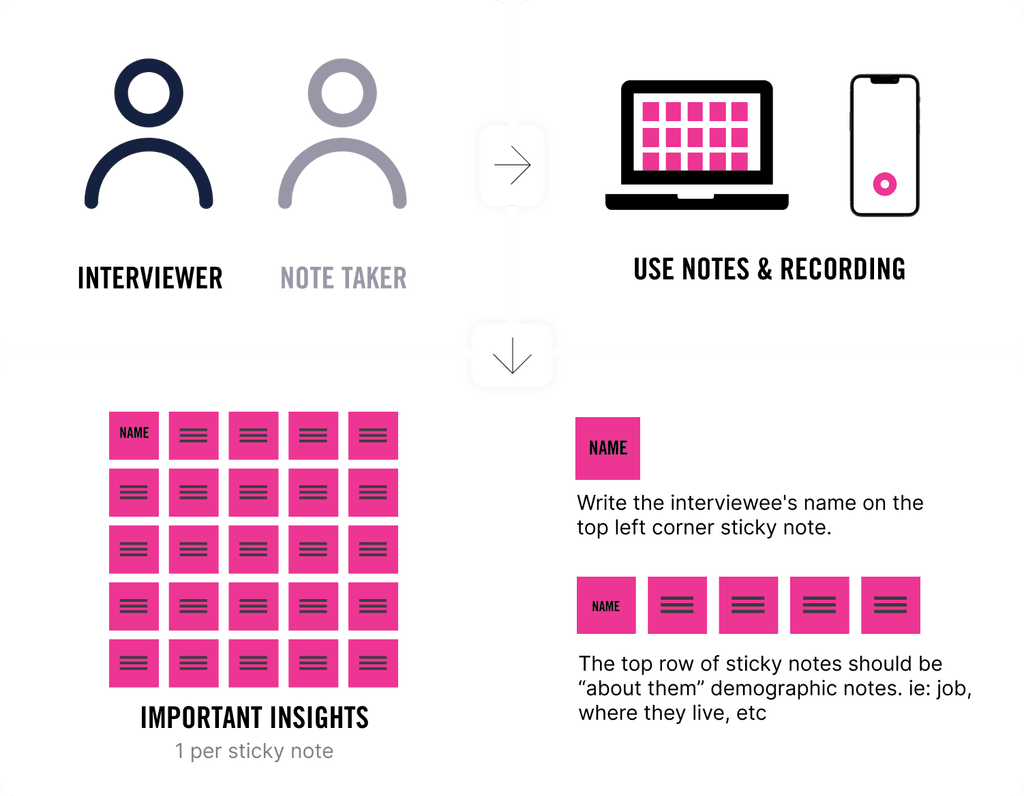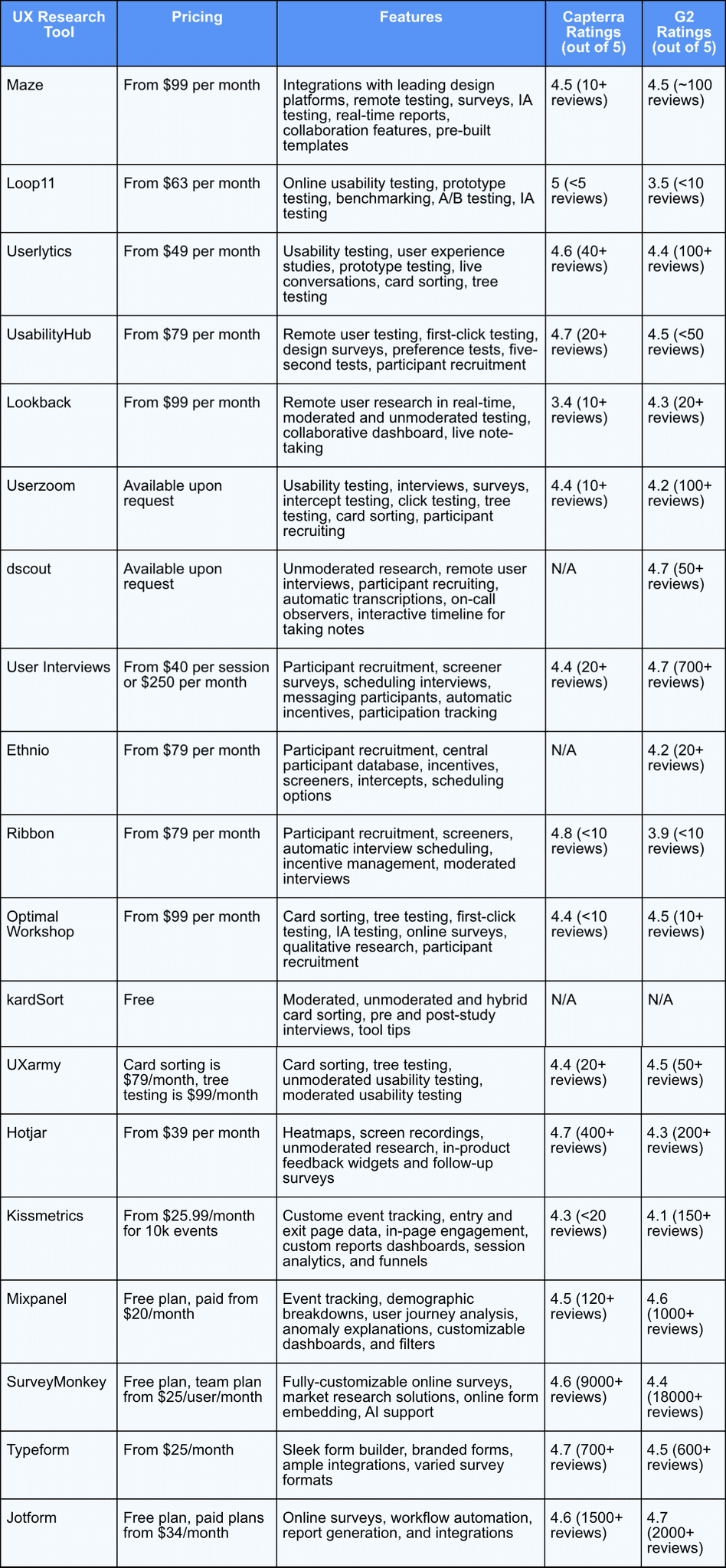RESEARCH
User Interviewing Guide
Best practices when conducting user interviews
ASKING QUESTIONS
What makes a good question?
• A good question, tells a good story...
• In that story, you get human behavior.
• You want to learn about problems & the experiences around the problems.
• Think about the persona framework: Needs/Goals, Behaviors/Activities, Pains
• Avoid leading questions
WHAT IS A LEADING QUESTION?
A leading question prompts or encourages as desired answer.
Example: You we're in LA last week, right? vs Where were you last week?
FRAMING QUESTIONS
Start high level & opened ended
Don't do this:
What do you use your Ipad for?
Why is this question not good?
It assumes too much—assumes someone uses an ipad
Start high-level & open ended, which will allow for you to learn much more:
How do you engage with technology? = Story
What do you use the most? = Importance
Why is do you use your ipad the most? = Activities/Needs
What are the most common reasons you use your ipad for? = Activities/Needs
How often and what triggers you to usually use your ipad? = Behaviors
Is there any problems/friction that you experience, if so please describe in detail? = Problems/Needs
DURING THE INTERVIEW
Spark conversations around
• Scenarios/Activities
• Real World Context
• Pains & Joys
• First Time & Most Recent Time
• Best Time & Worst Time
• Wish List
Conversation prompts
• Have you ever had an experience where (describe a scenario)?
• Can you tell me that story from beginning to end?
• And then what happen?
• Why (or how) did you do that?
• What did you love most about that?
• What did you not like about that, if any?
• If I can give you a magic wand, you get one wish— what would you improve regarding that experience and how would you improve it?
Tip:
Start your questions with why, what, where, how = Stories
Start your questions with do & is = yes & no answers
During the interview, it's best to:
• Smile
• Ask open ended questions
• Get their story
• Ask about past & current behaviors
• Be quiet & listen
• Ask why, how, what, when, where
During the interview, don't do:
• Talk about your product
• Talk the entire time
• Ask leading questions
• Ask about future behaviors!!!!!!!!!!!!!!!!
• Say, do you like it or would you use "product here"
• Don't cut people off unless absolutely necessary
• Sell
• Ask lots of yes & no questions that don't follow up
Follow this strategy called "the deep dive" when listening to someone tell the story:
Get their story first, then go back and dive into the areas that you wanted to when they were first telling you the story. Essentially, don't cut people off when their telling you a story from beginning to end.

SYNTHESIS
Interview Dynamics & Synthesis
In-person Interviews
2 Person Guide

After interview synthesis:
Debrief quickly after and write any top of mind "take aways."
Then use software to transcribe the audio (Descript) and
copy/paste insights into sticky notes—one color per interviewee.
A 1 hour interview can take 2-4 hours to get all the insights articulated and ready.

In-person Interviews
3 Person Guide

After interview synthesis:
Debrief quickly after and write any top of mind "take aways."
Collaborate with the note taker and go through their notes to write
insights together and make sure you captured all important insights.
You can also transcribe the audio (Descript) and copy/paste
insights into sticky notes—one color per interviewee.
A 1 hour interview can take 2-4 hours to get all the insights articulated and ready.

Remote Interviews
3 Person Guide

After interview synthesis:
Debrief quickly after and write any top of mind "take aways."
Collaborate with the note taker and go through their notes to write
insights together and make sure you captured all important insights.
Use the transcription from Zoom and copy/paste insights into sticky
notes—one color per interviewee.
A 1 hour interview can take 2-4 hours to get all the insights articulated and ready.

Onsite Observation Room
4+ Person Guide

Follow same "after interview" synthesis
Debrief quickly after and write any top of mind "take aways" with observers.
You should have a note taker here, as you could use one of the observers
After Many Interviews
You should have different color (one for each interviewee) user buckets:

How many interviews should you do before clustering (affinity mapping)?
Best practice is to have at least 5-7 completed to start seeing some patterns
Don't see patterns or need more data points? Keep interviewing & double check you're asking the right questions
UX RESEARCH TESTING TOOLS & AI TOOLS
List of industry tools
LookBack
Ideal for testing on mobile devices
Recording + screen touches
Research repository +transcriptions
Usertesting.com
Recruiting tool & testing tool
Setup, task & publish
View recording sessions & insights
Maze
Recruiting, survey, & testing tool
Visualizations & testing insights
View recording sessions & insights
'
ALL ON ONE
View this article
